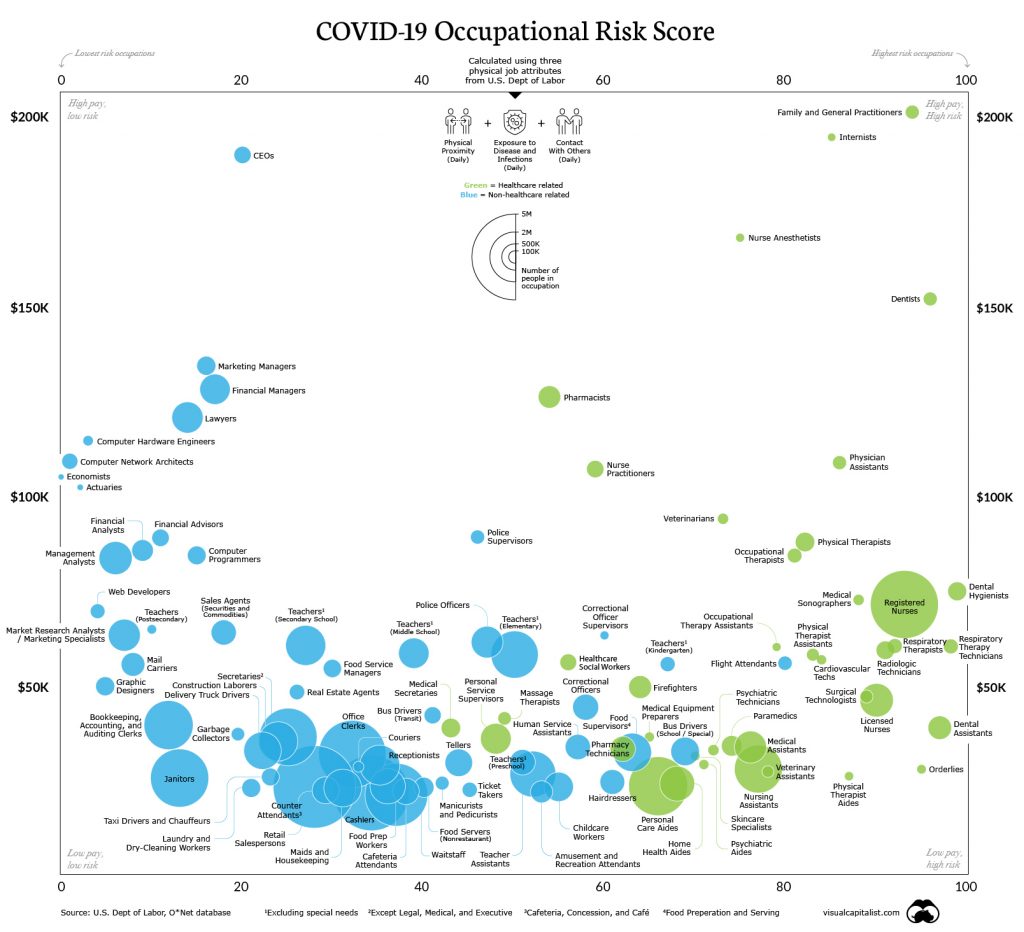There is an invisible problem in the dental profession which has the potential to be harmful to medical professionals, patients, office staff and family members. Indoor air within dental offices may contain unhealthy and infectious airborne particulate resulting from transmittable bacteria and viruses. Dental offices are high traffic, publicly accessible, commercial spaces and the multiple daily interactions between patients and staff, can introduce bacterial, viral and fungal infections into the air. Ultrasonic instruments, along with the constant cleaning and disinfection of contact surfaces can create bio-aerosols which contaminate the indoor air and degrade the air quality of air in a dental office.

(courtesy https://www.visualcapitalist.com — click image to expand)
Indoor air quality contamination has been a known concern for many years, especially within hospital and dental manufacturer’s environments. Operating rooms of all hospitals and surgery centers have a cooler and filtered positive air flow within each surgical suite. Manufacturers of surgically implanted hardware (orthopedic) and dental implants have source capture devices on their equipment and “Clean Rooms” as part of the final sterilization process to preserve the surfaces of the implants before packaging. The manufacturers of these products invest heavily in the design of air quality controls to ensure they meet industry, regulatory and governmental standards and to protect their staff and the end user of their final product.
Source capture of dental bio-aerosols effectively collects airborne contaminants that are often present in dental offices; including such as oral aerosols, ultra-fine particles, disinfectant odors, mercury vapor, drill aerosols and abrasion powder and provide an added layer of safety by improving air quality in the immediate vicinity of interaction between individuals. This “source capture” feature helps protect doctors, dental technicians and patients alike.
During a regular dental visit, patients and providers are exposed to bio-aerosols which can originate from contaminated patient care items. In dental offices, the oral cavity constitutes the highest reservoir of infectious organisms with over 350 different types of bacteria. During dental treatments, the use of high and low speed instruments drilling into teeth, bones and tissues create hazardous bio-aerosols. Aerosols containing microbes from the saliva, blood, and sub-gingival fluids are dispersed in the air. The dispersal of fine droplets, which may contain pathogens, can stay airborne for hours. These pathogens are easily inhaled and become a potential source of infection for everyone within the dental office. The amount of time these droplets remain suspended in the air, how far they travel, and their level of contamination should be a concern for everyone, and especially when treating highly vulnerable patients – children, pregnant women, older people, and patients with COVID specific co-morbidity factors, hypertension, obesity, COPD.
A typical dental office can see 40-50 patients in a day. These patients are another source of air pollution from the tiny particulates of skin which that are continually exfoliated from the skin. Researchers believe that the majority of Staphylococcus aureus, one of the leading causes of infection, is transported mainly on these shed skin particles, readily disturbed from floors and other surfaces as microscopic specks of dust which thousands of pathogens use as a transmission vehicle.
Despite the SARS (Severe Acute Respiratory Syndrome) and MRSA (Multi-Resistant Staphylococcus Aureus) epidemics which profoundly affected healthcare mortality and infection rates, concrete actions to prevent the spread of aerobiological viral and bacterial infections have not been taken.
The Occupational Safety and Health Administration (OSHA) mandates that every employer, including medical and dental offices, has a general duty to protect employees. OSHA industrial hygiene includes references to ventilation and replacement air for the protection of the workers. There should be adequate ventilation by either natural or mechanical means, in order that the atmosphere does not endanger the health and safety of workers. The replacement air shall be free from contamination with any hazardous dust, vapor, smoke, fumes, mist or gas. The discharge of air from any exhaust system shall be in such a manner so as to prevent the return of contaminants into any workplace.
Microbial air pollution is a health hazard and source capture filtration units can play a role in significantly reducing the transmittable bio-aerosols. In many medical and dental office environments, the most practical and convenient solution is to have source capture systems.
References
- https://www.osha.gov/SLTC/indoorairquality/
- https://www.cdc.gov/mrsa/healthcare/index.html
- https://www.cdc.gov/sars/
- https://www.apcfilters.com/importance-air-quality-dental-offices/
More Information
- Filter Boxes
- Inline fans with EC motors
- Roof Caps
- Wall Hoods
- Ductwork
- Backdraft Damper
- Email us at: team@hvacquick.com
- Need to build a system ? Call our customer service/tech team: 877.711.4822
